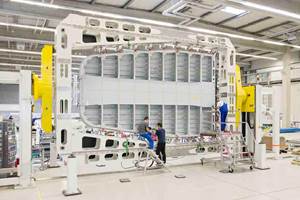Navy unveils unmanned composites-intensive vessel
This entirely new class of ocean-going vessel can traverse thousands of kilometers over the open seas for months at a time, without a single crew member aboard.
Earlier this month, the Defense Advanced Research Projects Agency (DARPA, Washington, DC, US) held a christening ceremony for the technology demonstration vessel it has developed and built through the Agency’s Anti-Submarine Warfare (ASW) Continuous Trail Unmanned Vessel (ACTUV) program. Called the “Sea Hunter,” the 130-foot drone vessel could be used for submarine tracking and countermine activities.
ACTUV is a 130-foot twin-screw trimaran, featuring a fiberglass composite exterior and foam core. The ship is designed for enhanced stability in all kinds of weather. It has a number of unusual features because it does not need to accommodate people. For example, interior spaces are accessible for maintenance but aren’t designed to support a permanent crew.
But of broader technical significance is that ACTUV embodies breakthroughs in autonomous navigational capabilities with the potential to change the nature of U.S. maritime operations, DARPA stated. Through at-sea testing on a surrogate vessel, ACTUV’s autonomy suite has proven capable of operating the ship in compliance with maritime laws and conventions for safe navigation—including International Regulations for Preventing Collisions at Sea, or COLREGS. ACTUV accomplishes this feat through advanced software and hardware that serve as automated lookouts, enabling the ship to operate safely near manned maritime vessels in all weather and traffic conditions, day or night.
ACTUV is designed to normally operate under sparse remote supervisory control but can also serve as a remotely piloted vessel, should the mission or specific circumstances require it. In either case, it would operate at a fraction of the cost of manned vessels that are today deployed for similar missions.
In September 2014, DARPA signed a Memorandum of Agreement (MOA) with the Office of Naval Research to jointly fund an extended test phase of an ACTUV prototype. DARPA will collaborate with ONR to fully test the capabilities of the vessel and several innovative payloads during open-water testing scheduled to begin this summer off the California coast after preliminary checkout and movement to San Diego. Pending the results of those tests, the program could transition to the U.S. Navy by 2018. Leidos (Reston, VA, US) is the company leading the team that built the ACTUV prototype and the construction took place at the Vigor Shipyard in Portland, OR, US.
“What we’ve created together with the Navy is a truck that can carry more payload over greater distances, stay out longer, and be more capable than anything else—and do it highly autonomously because it’s a big vessel and it’s got that flexibility,” said Scott Littlefield, DARPA program manager.
“As the chief mad scientists of the Navy, I say the best ships are partnerships,” said Rear Admiral Mathias Winter, chief of Naval Research, Innovation Technology Requirements and Test & Evaluation (OPNAV N84). “And the partnerships with DARPA, with Leidos, and our entire small, medium and large business base, and our thousands of academics and universities around the world will ensure that the Department of the Navy, the Department of Defense, and this great country and the 310 million Americans that call it home will continue to have the quality of life and the security they need as we continue to field and explore and experiment with capabilities like ACTUV.”
Here are highlights from on-water speed tests:
Related Content
Syensqo composites demonstrate titanium replacement on Boeing MQ-25 Stingray
Validation of integrating Cycom 5250-4HT prepreg into the UAV’s exhaust nozzle structure underpins the material system’s use in other high-temperature aerospace applications.
Read MoreCall for abstracts: CW Tech Days to explore high-temperature composite solutions
The fall 2025 installment of CW’s Tech Days online event series will cover high-temperature composite solutions for defense and space applications.
Read MoreFrom the CW Archives: Airbus A400M cargo door
The inaugural CW From the Archives revisits Sara Black’s 2007 story on out-of-autoclave infusion used to fabricate the massive composite upper cargo door for the Airbus A400M military airlifter.
Read MoreScaled Composites Model 437 aircraft to be flown for Beacon autonomy testbed
Northrop Grumman subsidiary part of Digital Pathfinder development of stealth aircraft with wings using continuous carbon fiber additive manufacturing and determinate assembly.
Read MoreRead Next
Ceramic matrix composites: Faster, cheaper, higher temperature
New players proliferate, increasing CMC materials and manufacturing capacity, novel processes and automation to meet demand for higher part volumes and performance.
Read MoreScaling up, optimizing the flax fiber composite camper
Greenlander’s Sherpa RV cab, which is largely constructed from flax fiber/bio-epoxy sandwich panels, nears commercial production readiness and next-generation scale-up.
Read MoreNext-gen fan blades: Hybrid twin RTM, printed sensors, laser shock disassembly
MORPHO project demonstrates blade with 20% faster RTM cure cycle, uses AI-based monitoring for improved maintenance/life cycle management and proves laser shock disassembly for recycling.
Read More












